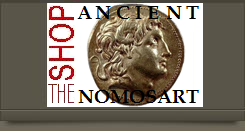
about ancient nomos
Ancient Nomos Art is a museum of galleries exhibiting ancient coins and ancient mint maps. The coin gallery displays the diverse art and history of hand-crafted ancient Greek, Roman, Byzantine, Persian and Medieval coinage. The ancient mints mapping gallery features Greek, Roman, Byzantine, Asia Minor and Medieval mint city regions and territories. Visitor's are welcome to explore, study and enjoy Ancient Nomos Art.

Imperial, Roman – 317 AD
Licinius II
From Ancient Galleries

Obverse: Laureate bust of a youthful Licinius II facing left, wearing his imperial mantle and holding a mappa, scepter, and small globe.
Reverse: Jupiter standing left, holding Victory on a globe in right hand and a scepter in his left. A small wreath and H are in the fields.
LEGEND
Obv: DN VAL LIC LICINIVS NOB C, Laureate bust of youthful Licinius II facing left, wearing imperial mantle, holding mappa, scepter, and globe. Rev: IOVI CONSERVATORI CAESS, Jupiter standing left, holding Victory on globe in his right hand and a scepter in his left hand. A wreath symbol appears in the lower left field; H in right field; SMK in exergue.
The Roman emperor Valerius Licinianus Licinius (known as Licinius II “the Younger”) was but an infant child during this youthful reign as a Caesar from 317 AD to 324 AD. His father was Augustus Licinius I, a Dacian from a peasant family in Moesia Superior, and his mother was Flavia Julia Constantia, sister of the Emperor Constantine the Great. Licinius’ father was a commander for Emperor Galerius during the Tetrarchy period. Following the abdication of Diocletian and Maximianus, Licinius “the Elder” was raised to the rank of Augustus after the death of Galerius in 311 AD, despite never having held the position of Caesar. At this time there were four different Roman’s calling themselves Emperors including; Licinius I “the Elder” in Asia, Daza Maximin in Egypt, Maxentius in Rome and Constantine “the Great” in Gaul. After Maximinus II invaded Licinius’ territories, Licinius marched against him and defeated the Maximinus army. Shortly after the birth of Licinius II he was elevated to the rank of “Caesar” by his father, in 317 AD, at the tender age of just 20 months. The above bronze follis is a perfectly executed, well detailed and sharply struck example of a youthful Licinius II, although he is depicted as a boy somewhat older than his actual age at the time. This bronze follis of Licinius II is quiet rare with full silvering and in such an exquisite state of preservation. Over the next few years of his life, relations between his father Licinius I and Constantine I deteriorated very rapidly. The two Augusti seniors constantly battled against each other until Licinius I was finally defeated by Constantine the Great at Chrysopolis on September 18, 324 AD. After his defeat, Licinius I was initially spared a death sentence and placed in captivity at Thessalonica. However, within a year Constantine the Great seems to have regretted his leniency and his former rival Licinius was hanged. Two years later, Constantine the Great had his son Licinius II “the Younger” executed as well at Pola, in 327 AD.
DOCUMENTATION
Value: Follis. Metal: AE Bronze. Weight: 3.10 grams. Mint: Cyzicus, 8th Officina. Date: 317-320 AD.
Attribution: Roman Imperial Coinage, VII, 11. Photo Courtesy CNG.
Legend, Documentation and Attribution
